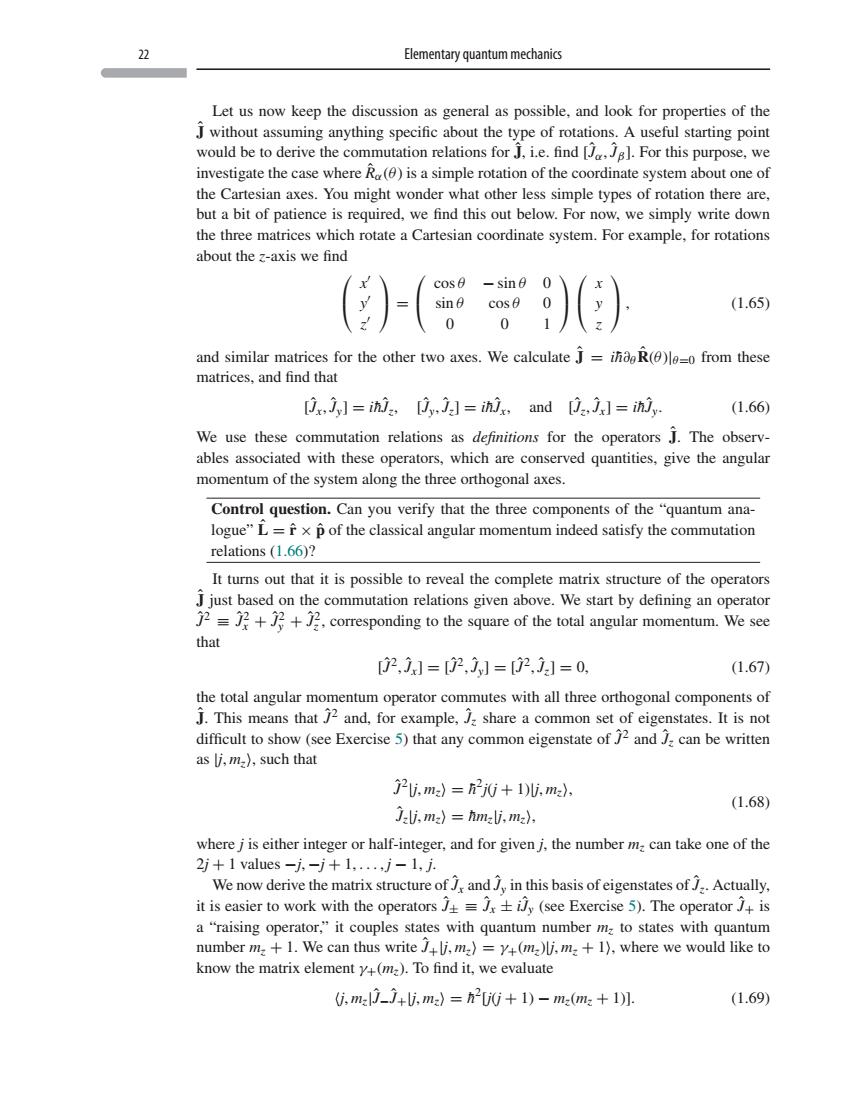正在加载图片...

22 Elementary quantum mechanics Let us now keep the discussion as general as possible,and look for properties of the J without assuming anything specific about the t e of rotations.A useful starting point would be to derive the investigate the case where R()is a simple rotation of the coordinate system about one of the Cartesian axes.You might wonder what other less simple types of rotation there are, but a bit of patience is required,we find this out below.For now,we simply write down the three matrices which rotate a Cartesian coordinate system.For example,for rotations about the z-axis we find )-(g) (1.65) and similar matrices for the other two axes.We calculate j=ihdeR()from these matrices,and find that [心,j]=i.心.j月=j,ndd.j]=, (1.66 We use these commutation relations as definitions for the operators J.The observ ables associated with these operators,which are conserved quantities,give the angular momentum of the system along the three orthogonal axes. Control question.Can you verify that the three components of the"quantum ana- logue"L=fx 6 of the classical angular momentum indeed satisfy the commutation relations(166)? It turs out that it is possible to reveal the complete matrix structure of the operator on the e commutation relations given above.We start by defining an operator comespondins to the square of the total anuar momentum. that (1.67 the total angular momentum operator commutes with all three orthogonal components of J.This means that )2 and.for example.share a common set of eigenstates.It is not difficult to show (see Exercise 5)that any common eigenstate of )2 and 7:can be written as li.m),such that P,m=0+1,m (1.68) J:lj.m2).m2). where jis either integer or half-integer,and for given j.the number mcan take one of the 2j+1 value +1 j-1, We now derive the matrix structure this basis of eigenstatesofActually. it is easier to work with the operatorsxiy(see Exercise 5).The operator J+is a"raising operator,"it couples states with quantum number mz to states with quantum number m:+1.We can thus write 7lj.m)=y(m)j.m:+1).where we would like to know the matrix element y(m).To find it,we evaluate ,m:_+.m)=0+1)-m:(m+1 (1.6922 Elementary quantum mechanics Let us now keep the discussion as general as possible, and look for properties of the Jˆ without assuming anything specific about the type of rotations. A useful starting point would be to derive the commutation relations for Jˆ, i.e. find [Jˆα, Jˆβ]. For this purpose, we investigate the case where Rˆ α(θ) is a simple rotation of the coordinate system about one of the Cartesian axes. You might wonder what other less simple types of rotation there are, but a bit of patience is required, we find this out below. For now, we simply write down the three matrices which rotate a Cartesian coordinate system. For example, for rotations about the z-axis we find ⎛ ⎝ x y z ⎞ ⎠ = ⎛ ⎝ cos θ − sin θ 0 sin θ cos θ 0 0 01 ⎞ ⎠ ⎛ ⎝ x y z ⎞ ⎠ , (1.65) and similar matrices for the other two axes. We calculate Jˆ = ih¯∂θRˆ (θ)|θ=0 from these matrices, and find that [Jˆx, Jˆy] = ih¯Jˆz, [Jˆy, Jˆz] = ih¯Jˆx, and [Jˆz, Jˆx] = ih¯Jˆy. (1.66) We use these commutation relations as definitions for the operators Jˆ. The observables associated with these operators, which are conserved quantities, give the angular momentum of the system along the three orthogonal axes. Control question. Can you verify that the three components of the “quantum analogue” Lˆ = rˆ × pˆ of the classical angular momentum indeed satisfy the commutation relations (1.66)? It turns out that it is possible to reveal the complete matrix structure of the operators Jˆ just based on the commutation relations given above. We start by defining an operator Jˆ2 ≡ Jˆ2 x + Jˆ2 y + Jˆ2 z , corresponding to the square of the total angular momentum. We see that [Jˆ2, Jˆx] = [Jˆ2, Jˆy] = [Jˆ2, Jˆz] = 0, (1.67) the total angular momentum operator commutes with all three orthogonal components of Jˆ. This means that Jˆ2 and, for example, Jˆz share a common set of eigenstates. It is not difficult to show (see Exercise 5) that any common eigenstate of Jˆ2 and Jˆz can be written as |j, mz, such that Jˆ2|j, mz = h¯ 2j(j + 1)|j, mz, Jˆz|j, mz = hm¯ z|j, mz, (1.68) where j is either integer or half-integer, and for given j, the number mz can take one of the 2j + 1 values −j, −j + 1, ... , j − 1, j. We now derive the matrix structure of Jˆx and Jˆy in this basis of eigenstates of Jˆz. Actually, it is easier to work with the operators Jˆ± ≡ Jˆx ± iJˆy (see Exercise 5). The operator Jˆ+ is a “raising operator,” it couples states with quantum number mz to states with quantum number mz + 1. We can thus write Jˆ+|j, mz = γ+(mz)|j, mz + 1, where we would like to know the matrix element γ+(mz). To find it, we evaluate j, mz|Jˆ−Jˆ+|j, mz = h¯ 2[j(j + 1) − mz(mz + 1)]. (1.69)